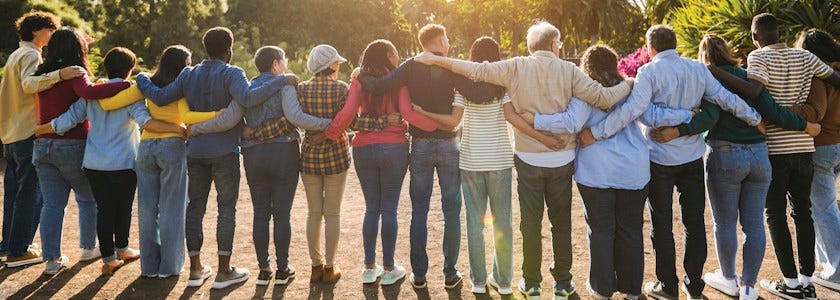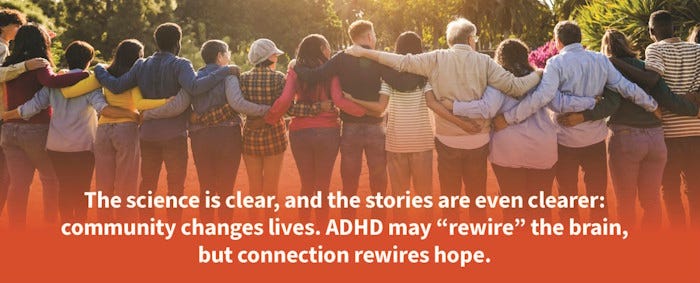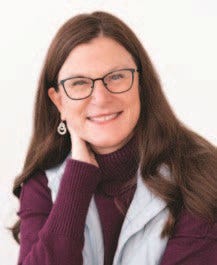The Power of Community and Connection: Thriving with ADHD Together
Living with ADHD can feel overwhelming, unpredictable, and isolating—but it does not have to be a solitary journey. The science is clear, and the stories are even clearer: community changes lives.
By Jane Indergaard, DNP, RN
For CHADD’s Attention Magazine
ADHD is a prevalent, biologically based condition
that changes how the brain develops and works. It’s not about being lazy or undisciplined—the brain is literally wired differently. This means that people with ADHD can have challenges with self-control, focus, managing their behavior, and staying organized, but it also comes with unique strengths and ways of thinking.
Nonetheless, parenting or living with ADHD doesn’t follow the usual playbook. Typical parenting strategies that work for neurotypical children often fall short, leaving caregivers feeling like they are constantly rewriting the rules. The patterns for managing daily life that neurotypical adults take for granted often don’t translate when one has ADHD, leaving individuals feeling embarrassed, frustrated, and isolated.
The fact is, for a child—or any individual—living with ADHD, navigating each day with an unpredictable brain requires tremendous energy, effort, and resilience that most neurotypical people cannot imagine. Additionally, due to the underlying challenges with self-regulation, ADHD has the potential for far-reaching effects on quality of life, achievement, health, relationships, and even life expectancy.
And yet, amidst the deluge of challenges, there is hope. While medication, therapy, coaching, and accommodations form the backbone of medical treatment, another powerful, often overlooked factor can transform the ADHD journey: community and connection.
Understanding the unique landscape of ADHD
Treatment for ADHD has evolved remarkably over the years, offering better tools and more comprehensive support. However, ADHD and its management are anything but one-size-fits-all. There is an enormous range of variability in symptoms, co-occurring conditions, and severity. As a result, effective treatment must be highly individualized.
ADHD is complex and a lifelong chronic condition with a fluctuating course. Unlike other chronic medical conditions such as heart disease, epilepsy, or diabetes, ADHD is rarely accompanied by formal psychoeducation or structured caregiver training at diagnosis. Families are left to search, research, and self-educate on how to manage the daily challenges ADHD presents.
Be part of the CHADD community and find the friendship and support you are looking for.
“Not knowing what to do, not having any information, having trouble getting her to take her medication,” shared one mother about her daughter diagnosed in sixth grade. “She was afraid of the medication until we talked to an ADHD expert at our local CHADD group. If I had had that information earlier, I would have tried it sooner. We had struggled for several years. There’s so much misinformation out there—junk—that I couldn’t discern what was good and what wasn’t. Even with higher education training, I was paralyzed.”
This lack of guidance often leaves parents and individuals feeling isolated and misunderstood. Despite being diagnosed and undergoing medical treatment, without ongoing education and support, they still find themselves searching for answers, sifting through endless dubious resources, and feeling as if no one truly understands.
Stigma only makes this harder. Despite advances in science, myths persist that ADHD is the result of poor parenting, laziness, or lack of moral character. These misconceptions not only create unwarranted shame but further isolate families at the very moment they most need support.
“I remember feeling like my kids were ‘different,’ and having to explain why one daughter couldn’t be outside when mowing because of her asthma, and the other was emotionally labile and needed cues for transitions,” a parent shared. “There’s this ongoing balance between offering excuses and real explanations, being believed, and trying to build habits and ‘good behavior.’ It’s exhausting, and without support, isolating.”
While medication, therapy, coaching, and accommodations form the backbone of medical treatment, another powerful, often overlooked factor can transform the ADHD journey: community and connection.
In the world of chronic medical conditions, ADHD has not shared the focus on training and education for lifelong management in the treatment setting, as do others. However, research on other chronic illnesses has shown a critical truth that we can borrow: connection is medicine.
The science of connection: why we need each other
Humans are wired to connect. Social bonds aren’t just “nice to have”—they’re a biological necessity. The American College of Lifestyle Medicine has called social connection a “pillar of lifestyle medicine,” as essential as sleep, nutrition, and exercise for overall well-being. Former US Surgeon General Vivek Murthy has gone further, calling for social connection to be treated as a vital sign of well-being and a public health priority, routinely monitored in the same way we check blood pressure.
Why? Because disconnection is dangerous. Without connection, stress levels rise, resilience falls, and both physical and emotional health suffer. Research shows loneliness and social isolation increase the risk of early death at rates comparable to smoking or obesity. A 2024 meta-analysis led by psychologist Julianne Holt-Lunstad confirmed that people who lack strong social ties face higher risks of poor health and shorter lifespans. In 2025, the World Health Organization estimated that loneliness contributes to more than 871,000 deaths worldwide every year, emphasizing that disconnection is a true health crisis.
For individuals and families affected by ADHD, this truth is even more profound. ADHD symptoms often lead to behaviors—impulsivity, distractibility, emotional dysregulation—that can strain relationships and make social connection more difficult. Not only is rejection a factor, but as a result of the strains caused by ADHD behaviors, many individuals and caregivers withdraw—not because they don’t crave connection, but because the risk of being judged or misunderstood feels too high.
“School was the hardest part for my son,” recalled a mother. “He had to work very hard, and some teachers helped unofficially, but we had almost no official support until high school. By then, his self-esteem was in the toilet, and he started down a risky path. The lack of ADHD knowledge from educators was heartbreaking — they didn’t see the need to level the playing field for a disability that isn’t outwardly visible. My son saw it, felt the rigid thinking, and grew frustrated — which turned into disrespect, a losing game for him.”
It’s easy to feel like an “island” of one when struggling with the challenges of ADHD. It’s tempting to pull away and believe that one’s journey will be a solo climb; but as the literature and many personal stories show, the most impactful journeys are built through the power of community and connection. It is there we can find strength, hope, and survival in each other.
An adult with ADHD reflected, “It’s all about validation. Being around others who have ADHD, you know they ‘get it.’ You don’t have to hide. That feeling of being understood fills a void you didn’t know was there.”
The risk of going it alone
Isolation can be devastating. Without connection, many individuals and families spiral into cycles of guilt, frustration, and loneliness. A parent may feel judged at school meetings. An adult with ADHD might hesitate to share their struggles for fear of being labeled lazy or irresponsible.
“For me, the anxiety came from all the ‘things’ after diagnosis: appointments, being pulled from class to take tests, taking medication, scheduling, and going to therapy. The stigma of being different was hard. I didn’t want people to know. The procrastination and initiation challenges didn’t go away—you have to learn to manage them constantly. It’s a lifelong thing,” shared a young adult with ADHD.
These patterns are not simply emotional—they can have an impact on treatment success. Isolated individuals are less likely to seek professional support, follow through with treatment plans, or advocate effectively for needed accommodations. Struggling silently, masking, and both pulling away or being marginalized causes individuals to miss out on practical tools and resources that could change their day-to-day lives.
Conversely, when community is present, the transformation is striking: Caregivers feel supported, individuals with ADHD develop self-acceptance, and practical, real-world strategies are shared among those who “get it.” Community acts as both a buffer and a bridge, transforming isolation into empowerment.
The emotional health of caregivers: a hidden key
One of the most powerful—but often overlooked—factors in the success of a child with ADHD is the emotional health of their primary caregiver. Parenting a child with ADHD is not simply more of the same parenting—it is different parenting. Day-to-day life with a child with ADHD demands relentless advocacy, creativity, patience, and energy more than most families ever anticipate. Without proper support, caregivers are at risk for burnout, depression, and anxiety.
Connection changes that. When caregivers find community, they gain:
The realization that “it’s not just me” lifts an enormous burden of shame.
Practical tools. Peer-shared strategies from people who have been there, for homework struggles, bedtime battles, and emotional meltdowns are often more effective than generic advice.
Emotional support from those who understand can buffer stress and improve well-being.
“When I found CHADD, I finally felt less alone,” a mother said. “Local leaders showed me what parents should be and do. Having kids with ADHD—two of them, plus myself—was overwhelming. But through shared experience, I learned to take care of myself too. I learned effective tools, like reframing my perspective, such as telling myself—my colicky, lively kid was just alive, not ‘difficult.’”
How community transforms the ADHD journey
When people with ADHD and their families find community, the benefits are both measurable and deeply personal. Key benefits include:
Reduced stress and anxiety. Strong social support lowers cortisol levels and improves coping skills. Simply having someone to talk to who understands the daily challenges can significantly reduce feelings of overwhelm.
Improved physical health. Connection isn’t just emotional—it’s biological. Supportive relationships are linked to better immune function, lower blood pressure, and longer lifespan.
Fostering self-acceptance. ADHD often comes with years of criticism and self-doubt. Hearing others share the same struggles replaces shame with understanding and compassion. Community offers a powerful counternarrative: “You are not broken. You are understood.”
A safe space for learning. Within a trusted community, caregivers and individuals with ADHD find space to vent, laugh, and learn without judgment. Practical problem-solving stems from shared experience, often offering the most effective tools.
Positive energy and hope. Community replenishes energy that ADHD drains. Shared victories, no matter how small, inspire confidence that progress is possible. Hope doesn’t come from being the same—it comes from being seen.
As one mother described, “I wanted trusted, local resources—not just random Google searches. CHADD helped me find a ‘personal board of directors’—people who understand and support me, even if we don’t talk every day.”
A mother with ADHD, parenting children with ADHD remarked, “Community helps you keep going when it’s exhausting and scary. It gives hope and reminds you there is a future, even when you can’t see it.”
CHADD: A lifeline for connection
Organizations like CHADD play a vital role in creating safe, informed, and welcoming spaces for individuals and families to connect, learn, and thrive. CHADD provides a trusted source of connection, education, and support.
Like ADHD itself, connection is not one-size-fits-all. Whether you prefer interactive support groups and online forums or webinars, articles, and self-paced learning, CHADD offers multiple pathways to community:
Local and virtual support groups. Safe spaces for sharing challenges and exchanging strategies.
Educational webinars and resources. Evidence-based tools for understanding and managing ADHD.
Peer-to-peer connection. Real stories from those who have walked the same path offer emotional relief and comfort.
Advocacy and training. Resources to help families work with schools, healthcare providers, and workplaces to secure accommodations and reduce stigma.
“CHADD helped me find like-minded people and trusted resources,” one parent said. “It’s freeing to be myself now, even if some friendships changed. Socializing drains me but knowing I’m not alone is huge. It takes a very large village to raise kids with ADHD.”
The power of “WE”
Living with ADHD—whether as an individual or a caregiver—can feel overwhelming, unpredictable, and isolating. But it does not have to be a solitary journey. When we connect, we heal. We share. We learn. We grow. We build structures that sustain families and individuals for the long term.
“Every tear and every victory have sent a ripple into the ADHD community,” said one parent. “Helping my son has helped so many others. My middle daughter struggled with my son’s embarrassing behavior, but over time, she softened. She married someone with ADHD, and now she helps others. And that is just one example of reaching out. What we learned, we shared with others who were struggling, and that’s a good thing.”
As demonstrated by this family’s experience, the cycle of connection and empathy builds bridges across generations and communities, turning isolation into collective strength.
Social connection is not a luxury—it is a lifeline. By fostering community, we not only help individuals with ADHD manage their symptoms but also create healthier families, stronger advocates, and ultimately, better outcomes for everyone.
The science is clear, and the stories are even clearer: community changes lives. ADHD may “rewire” the brain, but connection rewires hope.
This ADHD Awareness Month, let us remember: no one has to do this alone. Through organizations like CHADD, support groups, or even the quiet comfort of knowing “there are others like me,” we can transform ADHD from a source of isolation into a bridge to connection. Because in the end, the power of community is not just about support. It’s about survival. And it’s about thriving—together.
Jane Indergaard, DNP, RN, is a retired associate professor of nursing and scholar in residence at Concordia College in Moorhead, Minnesota. With forty-three years of clinical experience and thirty-nine years in higher education, she specializes in behavioral health and critical care nursing. For more than two decades, Dr. Indergaard has been a nationally and internationally recognized speaker, educator, and advocate for individuals with ADHD. A co-founder of the award-winning Red River Valley chapter, she currently serves on CHADD’s national board of directors, the advocacy and public policy committee, and the editorial advisory board for Attention magazine. She has contributed extensively to Attention and other media. Her current work focuses on advancing ADHD education, advocacy, and research, particularly in the areas of women’s health, the aging ADHD brain, and targeted psychoeducational programming.




